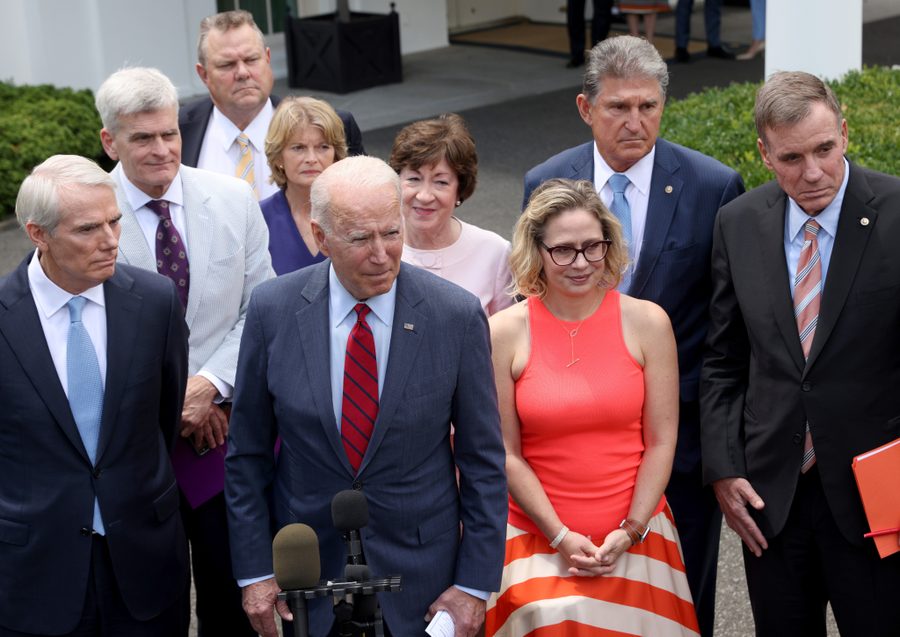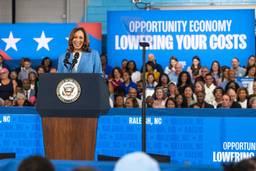Democrats Are Wasting Precious Time with a Measly "Bipartisan" Infrastructure Deal
The bipartisan plan is a drop in the bucket. Democrats need to forget Republicans and pass a bold package that makes massive public investments.
Max B. Sawicky

In his classic 1958 book The Affluent Society, economist John Kenneth Galbraith wrote, “Here, in an atmosphere of private opulence and public squalor, the private goods have full sway.” Nearly 70 years on, Galbraith is still right. For a country like the United States where the availability of safe drinking water is hit-and-miss, squalor is the right word — moral as well as physical.
A Twitter wag noted that we are flying helicopters remotely on Mars and broiling in Texas because scientists are in charge on Mars and Republicans are in charge in Texas. Climate change and the current struggle against the pandemic typify the risks of public squalor — the incapacity to mobilize collective resources to address collective problems.
In the U.S. Congress, plans to remedy this situation are afoot, ranging from paltry to ample, but ample is not coming easy.
The Democrats are eyeing a $4 trillion budget increase. This spending would be spread out over 10 years, but in the context of recent federal budget history, it’s still a departure. For instance, $400 billion a year might be two percent of U.S. GDP in 2021, which would be big by historical standards. For something resembling a democratic socialist budget comparable to European social democracies, more like ten percent of GDP would be needed. But in light of the narrowness of the Democrats’ majorities in Congress, two percent is not shabby, especially coming on the heels of the recent $2 trillion Covid-19 relief package, the American Rescue Plan (ARP).
Under budget reconciliation rules, Democrats can pass any tax-spending package they want with 50 votes. For instance, Senator Bernie Sanders (I-Vt.) who heads the Senate Budget Committee is developing a $6 trillion plan for physical and human infrastructure that would include policies from both American Jobs Plan and American Rescue Plan. The constraint on passing such a plan now is not the Republicans or the filibuster — it’s a handful of nominal Democrats within the Senate caucus. Democratic Sens. Joe Manchin of West Virginia and Kyrsten Sinema of Arizona get all the brickbats, but hiding behind them are a few more laggards. It may not be possible to completely buy out the dismal duo of Sinema and Manchin, but if they can be rented to vote for a Democratic plan, there is nowhere for the backsliders to hide. There is lots of room in a multi-trillion-dollar package for sending some goodies to West Virginia and Arizona.
The chief sticking point now is the hidebound concern about “pay-fors,” on the pretext of precluding unhappy increases in the national debt. Since there’s still has a long ways to go to reach “full” employment, especially for communities of color, deficit worries are ill-timed. An economic downturn, when employment is below par and interest rates are rock-bottom, is the right time to launch a new wave of public investment.
A word about investment, which has come to be the progressive adjective for Everything We Like. Non-investment, also known as consumption, can be good too. An example is the expanded child tax credit that was included in the ARP — not investment, but still good. The same goes for reducing the Medicare eligibility age down to 60, as has been proposed by Sanders and other progressives.
For their part, Republicans have been griping about loose notions of “infrastructure.” With government investment, what’s in question is not necessarily bricks and mortar, so to speak, but public capital. A water system is capital. So is a broadband network. Capital expenditure boosts employment in the short term and economic growth in later years, just as in the private sector.
Current public spending formally classified as investment is predominantly roads. The aversion to an expansion of public capital is really a rejection of the need to address climate change, especially with a new, optimized power grid, but also with social transportation that relies less on roads. People talk about high-speed rail, but that is inter-city transportation. The working class mainly needs the homely bus and regional rail options for commuting and shopping.
Besides pay-fors, the other dodge away from expanding and enhancing the public capital stock (in composition as well as volume) is privatization. The most obvious risk is the simple rip-off of transferring public facilities to private ownership at fire-sale prices, in keeping with the capitalist looting of the welfare state, or the disastrous Chicago parking meter scam, enacted and then expanded, respectively, by ex-Mayors Richard M. Daley and Rahm Emanuel.
Even if everything is on the up and up, however, privatization still places a natural economic barrier to the expansion of investment, since it depends on the prospect of corporate profits financed by user fees. For investment oriented to combating climate change, user fees are intrinsically inadequate to finance what is needed. Social benefits always exceed individuals’ willingness to pay.
The excuse for privatization is usually to protect against increases in public debt, but as many economists of different persuasions have pointed out, there are other ways of reducing the net worth of the government without a literal, economically equivalent increase in debt. The so-called “savings” of privatization in this sense are illusory. Selling a public asset at below its value is one example. Another is giving away a drug patent made possible by publicly funded research. Privatization’s claim to conserve public resources usually relies on sketchy accounting.
Such attempts to use privatization to address the crises we face are reportedly being packaged into the current bipartisan “gang of 20” infrastructure proposal being hammered out in Congress. Such an approach wouldn’t just fly in the face of President Biden and the Democrats’ stated agenda to massively invest public dollars to boost physical and human infrastructure — it would actively undermine it.
If the shaky moderate Democrats in the Senate are able to sign onto a measly compromise bill, of the type presented by President Biden and a bipartisan group of senators at the White House on Thursday, it may be hard to move them on to additional spending in a reconciliation package. They can claim to their voters that they chose bipartisanship, fiscal prudence and independence from their socialist (sic) brethren.
There are four bright lines that distinguish a genuinely progressive budget proposal from business-as-usual:
- Postponing concern with “pay-fors” until justified by employment levels and inflation risk.
- Instituting green requirements for investment, which among other things means modernizing a national power grid and investing in a dramatic expansion of social transportation and sustainable energy sources.
- Resisting the delusions of privatization.
- Ensuring that new investment is undertaken with upgraded labor standards.
One would think that Democrats understand they are on a clock. Unless they deliver the goods by the fall of next year, they are likely to be excluded from power altogether for the foreseeable future, facing an uphill battle in the 2022 midterm elections, with Republicans threatening to enshrine minority rule. In this light, the appeal of compromises that vitiate the extent of benefits in jobs, income and investment — and that also flout themes that animate the Democrats’ electoral base, such as climate change and racial justice — fades away to nothing. The real weapon on the Republican side is their ability to waste precious time.
The Biden administration seemed to recognize this by setting a deadline for the completion of a bipartisan proposal at the end of June, but now the deadline has been met. A passable deal that would coopt Republicans takes some steam out of their fulminations, but the new compromise is short of passable — promising only $579 billion in spending over ten years. It provides little of significance to voters while handing Sinema and Manchin an escape hatch.
The better path is the one being pursued by Sanders and his Democratic allies, using reconciliation to pass a massive plan that includes whatever they can browbeat Sinema and Manchin into accepting, unencumbered by Republican fiscal canards.
Max B. Sawicky is an economist and writer in Virginia, formerly with the Government Accountability Office and the Economic Policy Institute. He is a Senior Research Fellow at the Center for Economic and Policy Research and runs the MaxSpeak, You Listen! blog at sawicky.substack.com.








